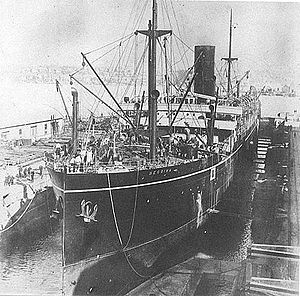HMAS Berrima
| 50x40px | This article includes a list of references, related reading or external links, but its sources remain unclear because it lacks inline citations. Please improve this article by introducing more precise citations where appropriate. (September 2008) |
 HMAT Berrima | |
| Career (Australia (RAN)) | |
|---|---|
| Owner: | P & O |
| Builder: | Caird & Co, Greenock |
| Launched: | 13 September 1913 |
| Acquired: | 1914 by RAN |
| Commissioned: | 17 August 1914 |
| Decommissioned: | 20 October 1914 |
| Fate: | converted to troop ship, later damaged |
| Career (United Kingdom) | |
| Name: | SS Berrima |
| Operator: | P & O |
| Acquired: | 1914 |
| In service: | 24 March 1920 |
| Honours and awards: |
Battle honours: Rabaul 1914[1][2] |
| Fate: | sold for breaking up September 1939 |
| General characteristics | |
| Tonnage: | 11,137 gross tons |
| Length: | 500 ft (150 m) |
| Beam: | 62 ft (19 m) |
| Draught: | 38 ft (12 m) |
| Speed: | 14 knots (26 km/h) |
| Armament: | 4 x 4 inch guns |
HMAS Berrima was an Armed Merchant Cruiser which served in the Royal Australian Navy (RAN) during World War I.
The P&O passenger liner SS Berrima was requisitioned for use by the Navy, refitted and armed at the Cockatoo Island Dockyard and commissioned into the RAN as the auxiliary cruiser HMAS Berrima.
Berrima left Sydney on 19 August 1914 carrying men of the Australian Naval and Military Expeditionary Force, consisting of a battalion of 1,000 infantry and a small battalion of 500 Naval Reservists and time-expired Royal Navy seaman, for operations against the German New Guinea colonies. Troops were landed at Herbertshöhe and Rabaul on 11 and 12 September respectively, and on the New Guinea mainland on 24 September. The ship was retroactively awarded the battle honour "Rabaul 1914" in March 2010 to recognise these landings.[1][2] Berrima subsequently returned to Sydney and, despite plans to employ her as an armed merchant cruiser, she was paid off in October and converted to a troop transport.
In her new role, HMATT (His Majesty's Australian Troop Transport) Berrima sailed for the Middle East in December 1914 as part of the second troop convoy, carrying Australian and New Zealand troops and towing the submarine AE2. Berrima continued to work under the liner requisition scheme until 18 February 1917, when she struck a mine in the English Channel off Portland and was beached and later repaired.
Berrima was returned to commercial service 24 March 1920, and was sold to Japanese shipbreakers in September, 1939.
References
- ↑ 1.0 1.1 "Navy Marks 109th Birthday With Historic Changes To Battle Honours". Royal Australian Navy. 1 March 2010. http://www.navy.gov.au/Navy_Marks_109th_Birthday_With_Historic_Changes_To_Battle_Honours. Retrieved 14 March 2010.
- ↑ 2.0 2.1 "Royal Australian Navy Ship/Unit Battle Honours". Royal Australian Navy. 1 March 2010. http://www.navy.gov.au/w/images/Units_entitlement_list.pdf. Retrieved 14 March 2010.
- British Warships 1914-1919 by Dittmar, F.J. and Colledge, J.J. Ian Allan, London; (1972), ISBN 0-7110-0380-7
- Australia's Ships of War by John Bastock. Angus and Robertson, Sydney; (1975), ISBN 0-207-12927-4
- Naval Reservists in WWI – first to fight, first to fall[dead link] by LCDR Glenn Kerr, RAN in Navy Reserve News Volume 9 Number 5, May 27, 2002 retrieved 1 Jan 2007.
- Jeremy, John, Cockatoo Island: Sydney's Historic Dockyard, p. 115. UNSW Press, Kensington (2005). ISBN 0 86840 817 4
External links
- Pages with broken file links
- Articles lacking in-text citations from September 2008
- Articles with invalid date parameter in template
- All articles lacking in-text citations
- All articles with dead external links
- Articles with dead external links from September 2008
- Royal Australian Navy troop ships
- Ocean liners
- Clyde-built ships
- Troop ships of the United Kingdom
- 1913 ships
